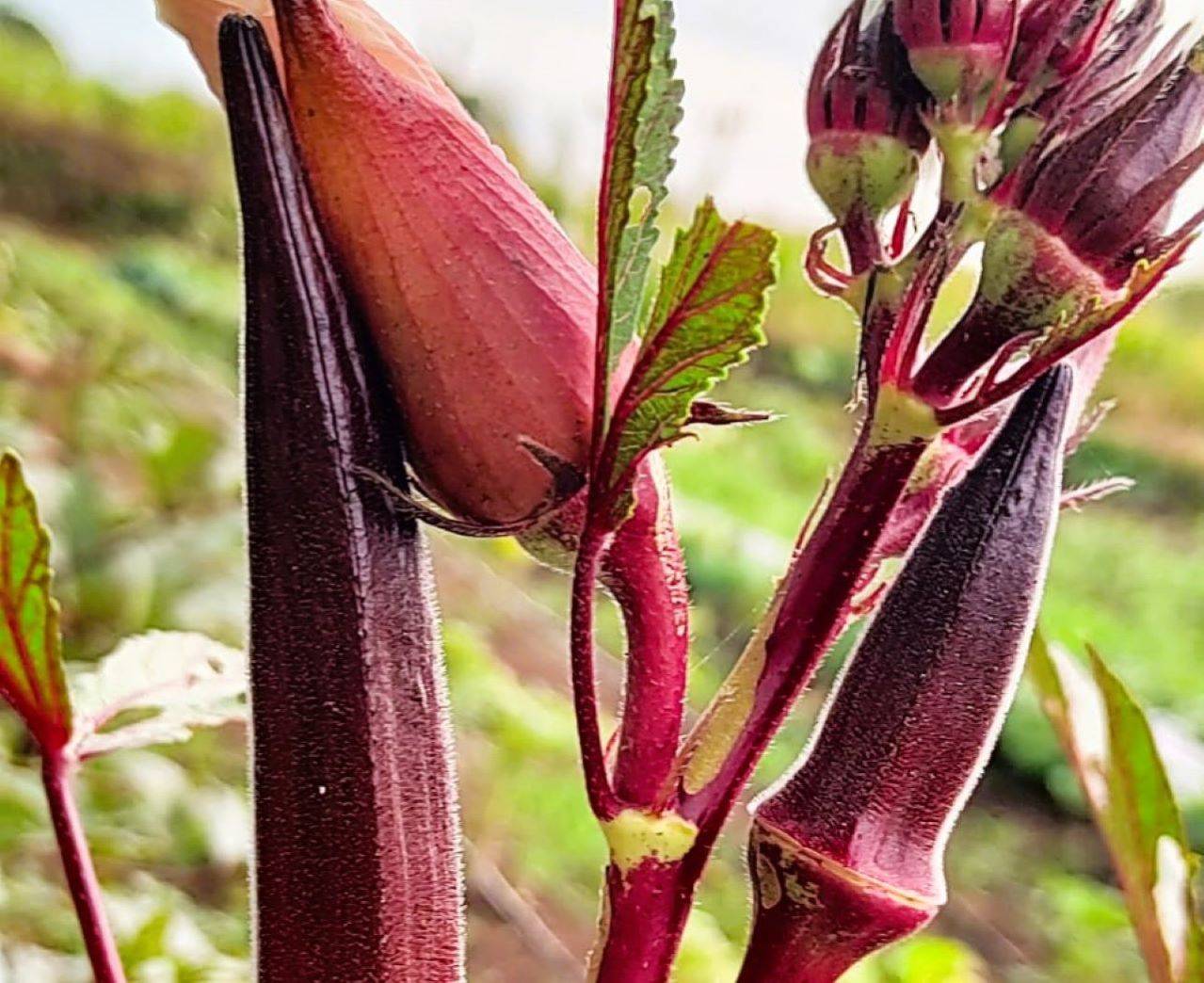
India leads global okra production, accounting for 63% of the world's output at 6.35 million tonnes from 0.519 million hectares (FAOSTAT 2020). Okra is a significant export commodity, contributing to 13% of fresh vegetable exports. In response to the growing demand for red okra rich in anthocyanin, the ICAR-Indian Agricultural Research Institute, New Delhi, has introduced a new variety named Pusa Lal Bhindi-1. This variety, approved by the State Seed Committee for Agricultural & Horticultural Crops, Government of NCT of Delhi on January 17, 2023, is high-yielding and moderately resistant to diseases such as YVMV and ELCV.
Pusa Lal Bhindi-1 (DOV-68)
The fruits of Pusa Lal Bhindi-1 (DOV-68) are reddish purple. It is moderately resistant to Bhendi yellow vein mosaic (YVMV) and Enation leaf curl virus (ELCV) diseases. All plant parts including stem and petioles are reddish purple. It yields 15 t/ha on short internodes. It is rich in anthocyanin (130 μg/g) and antioxidant content (357 μg/g GAE). It is suitable for both summer and kharif seasons.
Plant Morphology and Characteristics:
The plant is straight with 3-4 branches having dark red stems and petioles. Leaves are green with reddish veins and medium lobbing and serration. The flower is yellowish purple and the petals have purple claws at the base on both sides. Fruits are attractive dark reddish-purple color with 5 ridges, smooth surface, medium in length (10-12 cm), and less hairy.
1. Climatic Requirement
It is a warm-season vegetable crop and requires a long warm growing season. The seeds will not germinate below 18°C. It is susceptible to frost and will not thrive well when there is a continuous cold spell.
2. Soil
It can be grown in all kinds of soils, but sandy loam, friable and rich in organic contents is considered good for its cultivation.
3. Seed Rate
12-15 kg/ha during spring-summer season. 8-10 kg/ha during rainy season. Sowing can be done throughout the year when frost and severe winters are absent. In plains and frost-free areas, the first sowing is done from the second fortnight of February to March and the second during June to July. It is sown on flat beds, but in high rainfall or waterlogged areas, it should be sown on raised beds.
-
Spacing: Row to row: 45 cm during spring and summer, and 60 cm during kharif.
-
Plant to plant: 15 cm during spring-summer and 20 cm during kharif.
4. Manure and Fertilizers
Twenty tonnes of well-rotted Farm Yard Manure, along with N: P: K @100:60:80 kg/ha should be applied. One-third dose of nitrogen and a full amount of phosphorus and potash should be applied at the last field preparation just before sowing. Remaining nitrogen (2/3) should be applied in three equal split doses at 30, 45, and 60 days after sowing.
5. Irrigation
The crop should be irrigated as per requirement during summer and whenever required in the rainy season. Always give light irrigation.
6. Intercultural Operations
Apply pendimethalin solution at 3 liters/ha in 500 liters of water immediately after sowing, when there is sufficient moisture in the soil. Manual weeding should be done as per need, and earthing up in the rows should be done after weeding, especially during the rainy season.
7. Harvesting:
Fruits are continuously harvested 5 to 6 days after the opening of flowers when they are tender. The growth and bearing of the plant are adversely affected if the fruits are not harvested timely.
8. Average Yield:
120 q/ha during spring-summer season and 150 q/ha during kharif season.
Plant Protection:
1. Insect-Pests - Jassid or Leaf Hopper:
These insects are greenish-yellow in color. Both adults and nymphs suck the sap from the lower surface of leaves, causing curling and burning effects on the leaf edges. The insects lay small whitish round eggs on the lower surface of leaves.
Control: Alternately spray systemic insecticides such as acetamiprid at 0.3-0.5 ml/liter solution and spiromesifen at 0.5 ml/liter of water at 10-day intervals.
2. Shoot and Fruit Borer:
The larvae bore into tender shoots and fruits, causing stunted growth and rendering fruits unfit for consumption.
Control: Spray neem seed kernel extract (5%) or malathion at 2 ml/liter or spinosad at 1 ml/3 liters of water at 10-day intervals. Install pheromone traps at 20 traps/ha to capture male insects.
3. Whitefly:
Adults and nymphs suck sap from the lower leaf surface, damaging crops by transmitting Bhendi yellow vein mosaic virus.
Control: Sow 3 rows of maize/bajra around the field borders 45 days in advance. Install yellow sticky traps at 20 traps/ha. Alternately spray systemic insecticides like acetamiprid at 0.03-0.05% solution followed by spiromesifen at 0.5 ml/liter of water at 10-day intervals.
4. Red Spider Mites:
These tiny insects are light reddish-yellow and make nets on the lower leaf surface. Adults suck sap, causing yellowing and necrotic effects on leaves.
Control: Spray miticides such as propagate or spiromesifen at 2 ml/liter of water at 10-day intervals.
5. Bhendi Yellow Vein Mosaic Virus:
A vein-clearing virus disease transmitted by whitefly, causing yellowing of leaves and affecting fruiting.
Control: Similar control measures to those used for whitefly.
6. Enation Leaf Curl Virus:
Symptoms include curling, shortening, and thickening of leaves, stem bending, and no flowering or fruiting.
Control: Similar control measures to those used for whitefly.
(Source: Yadav, R. K. ., & Lata, S. . (2024). Pusa Lal Bhindi-1: Anthocyanin Rich Okra. Indian Horticulture, 69(2), 3-5. https://epubs.icar.org.in/index.php/IndHort/article/view/132691)
















